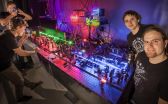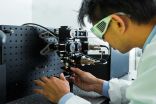(Press-News.org) In the last 10 years, computer security researchers have shown that malicious hackers don't need to see your data in order to steal your data. From the pattern in which your computer accesses its memory banks, adversaries can infer a shocking amount about what's stored there.
The risk of such attacks is particularly acute in the cloud, where you have no control over whose applications are sharing server space with yours. An antagonist could load up multiple cloud servers with small programs that do nothing but spy on other people's data.
Two years ago, researchers in the group of MIT's Srini Devadas, the Edwin Sibley Webster Professor in MIT's Department of Electrical Engineering and Computer Science, proposed a method for thwarting these types of attacks by disguising memory-access patterns. Now, they've begun to implement it in hardware.
In March, at the Architectural Support for Programming Languages and Operating Systems conference, they presented the layout of a custom-built chip that would use their scheme, which is now moving into fabrication. And at the IEEE International Symposium on Field-Programmable Custom Computing Machines in May, they will describe some additional improvements to the scheme, which they've tested on reconfigurable chips.
The principle behind the scheme is that, whenever a chip needs to fetch data from a particular memory address, it should query a bunch of other addresses, too, so that an adversary can't determine which one it's really interested in. Naturally, this requires shipping much more data between the chip and memory than would otherwise be necessary.
To minimize the amount of extra data needed, the researchers store memory addresses in a data structure known as a "tree." A family tree is a familiar example of a tree, in which each "node" (a person's name) is attached to only one node above it (the node representing the person's parents) but may connect to several nodes below it (the person's children).
Every address is randomly assigned to a path through the tree -- a sequence of nodes stretching from the top of the tree to the bottom, with no backtracking. When the chip requires the data stored at a particular address, it also requests data from all the other nodes on the same path.
In earlier work, researchers in Devadas' group were able to prove that pulling data from a single path was as confounding to an adversary as if the chip had pulled data from every single memory address in use -- every node of the tree.
Breaking the logjam
After reading data from a path, however, the chip also has to write data to the whole path; otherwise, an adversary could determine which node was the one of interest. But the chip rarely stores data in the same node that it read it from.
Most nodes lie on multiple paths: To take the most basic example, the single node at the top, or root, of the tree lies on every path. When the chip writes a block of data to memory, it pushes it as far down the tree as it can, which means finding the last vacancy before the block's assigned path branches off from path that was just read.
"The root of the tree is a lot smaller than the bottom of tree," says Albert Kwon, an MIT graduate student in electrical engineering and computer science and one of the papers' co-authors. "So intuitively, you want to push down as far as you can toward the bottom, so that there's no congestion at the top."
In writing data, the chip still has to follow the sequence of nodes in the path; otherwise, again, an adversary might be able to infer something about the data being stored. In previous attempts at similar systems, that meant sorting the memory addresses according to their ultimate locations in the tree.
"Sort is not easy to do in hardware," says Chris Fletcher, another graduate student in Devadas' group and first author on the new paper. "So by the time you've sorted everything, you've taken a real performance hit."
In the chip described in their latest paper, Fletcher, Devadas, Kwon, and their co-authors -- Ling Ren, also an MIT graduate student in electrical engineering and computer science, and colleagues at the University of Connecticut, the University of California at Berkeley, and the Qatar Computing Research Institute -- took a different approach. They gave their chip an extra memory circuit, with storage slots that can be mapped onto the sequence of nodes in any path through the tree. Once a data block's final location is determined, it's simply stored at the corresponding slot in the circuit. All of the blocks are then read out in order.
Stockpiled secrets
The new chip features another trick to improve efficiency: Rather than writing data out every time it reads data in, it writes only on every fifth read. On the other reads, it simply discards all of the decoy data. When it finally does write data back out, it will have, on average, five extra blocks of data to store on the last path it read. But there are generally enough vacancies in the tree to accommodate the extra blocks. And when there aren't, the system's ordinary protocols for pushing data as far down the tree as possible can handle the occasional logjam at the top.
Today's chips have small, local memory banks called caches in which they store frequently used data; for applications that use caching efficiently, all that extra reading and writing generally increases computation time by only about 20 percent. For applications that don't use caching efficiently, computation time can increase fivefold, or even more.
But according to the researchers, one of the advantages of their scheme is that the circuits that implement it can simply be added to existing chip designs, without much retooling. The extra layer of security can then be switched on and off as needed. Some cloud applications may use it all the time; others may opt against it entirely; still others may activate it only when handling sensitive information, such as credit card numbers.
INFORMATION:
Related links
ARCHIVE:
Detecting program-tampering in the cloud
ARCHIVE:
Protecting data in the cloud
ARCHIVE:
Securing the cloud
Tropical plantations in Southeast Asia have supplied most of the essential, natural rubber for truck, car and airplane tires for the past century. Now the tire industry and others say they're finally overcoming long-standing challenges to turn a desert shrub into an alternative source of the stretchy material. An article in Chemical & Engineering News (C&EN) explains that the latest developments will help diversify an otherwise vulnerable supply chain.
Alexander Tullo, a senior correspondent at C&EN, explains that natural rubber has unique properties that make it ideal ...
Rapidly swinging from extremes of joy and energy to sadness, fatigue, and confusion, bipolar disorder (BD) patients feel desperate and largely alone in the world. And according to the National Institutes of Health, between 25-50 percent of the roughly 3% of Americans living with BD attempt suicide at least once. Lithium is among the most effective therapies for BD, and remains the first-line treatment even as other mood stabilizing drugs have become available. But about half of the patients prescribed lithium do not respond to the treatment.
A new Tel Aviv University ...
TORONTO, April 22, 2015 -- A genetic test that can prevent 'killer' bees from spreading around the world has been created in a research effort led by University of Sydney scholars jointly with York University scientists.
"Our genetic test is highly accurate and considerably more sophisticated than the old tests that have a high tendency to misclassify hybrid bees," says Professor Amro Zayed in the department of Biology, Faculty of Science.
Africanized honeybees are highly aggressive and very difficult to manage relative to European honeybees used by Canadian and Australian ...
In the most comprehensive study ever on the impact of smoking on cardiovascular disease in older people, epidemiologist Dr. Ute Mons from the German Cancer Research Center (Deutsches Krebsforschungszentrum, DKFZ) analyzed 25 individual studies, compiling data from over half a million individuals age 60 and older.
Twice as many smokers die from cardiovascular disease than life-long non-smokers do. The increase in risk depends on the number of cigarettes that a person has smoked in his or her lifetime. After one quits smoking, this risk continues to decrease. On average, ...
In the quantum world of light, being distinguishable means staying lonely. Only those photons that are indistinguishable can wind up in a pair, through what is called Hong-Ou-Mandel interference. This subtle quantum effect has been successfully imaged for the first time by two doctoral students from the Faculty of Physics at the University of Warsaw.
Physicists have long known that photons can become bunched together. However, technological limitations have prevented the phenomenon from actually being observed directly. Only recently has this feat been achieved by two ...
Bethesda, MD, April 20, 2015: The Association for Molecular Pathology (AMP), the premier global, non-profit organization serving molecular diagnostic professionals, today published a special article in The Journal of Molecular Diagnostics titled, "Do Circulating Tumor Cells, Exosomes, and Circulating Tumor Nucleic Acids Have Clinical Utility?" The report provides a thorough overview of research to-date on the minimally invasive "liquid biopsy" approaches to cancer diagnostics.
"As a group of molecular diagnostic experts, we were intrigued and excited by the emerging ...
Hasbro Children's Hospital study finds link between adverse childhood experiences and pediatric asthma
Children who experience violence, substance abuse at home
report significantly higher rates of asthma
PROVIDENCE, R.I. - Robyn Wing, M.D., an emergency medicine physician at Hasbro Children's Hospital, recently led a study that found children who were exposed to an adverse childhood experience (ACE) were 28 percent more likely to develop asthma. The rate of asthma occurrence further increased in children with each additional ACE exposure. The study, recently published ...
Scientists have for the first time captured live images of the process of taste sensation on the tongue.
The international team imaged single cells on the tongue of a mouse with a specially designed microscope system.
"We've watched live taste cells capture and process molecules with different tastes," said biomedical engineer Dr Steve Lee, from The Australian National University (ANU).
There are more than 2,000 taste buds on the human tongue, which can distinguish at least five tastes: salty, sweet, sour, bitter and umami.
However the relationship between the ...
Rather than slowing down, ants speed up in response to a higher density of traffic on their trails, according to new research published in Springer's journal The Science of Nature - Naturwissenschaften. When the researchers increased the supply of food by leaving food next to the trail, ants accelerated their speed by 50 percent. This was despite more than double the density of traffic.
When food increases in supply, more forager ants are sent out to carry it back to the nest. With this increase in ant density, the number of encounters between outbound and incoming individuals ...
The ability of materials to conduct heat is a concept that we are all familiar with from everyday life. The modern story of thermal transport dates back to 1822 when the brilliant French physicist Jean-Baptiste Joseph Fourier published his book "Théorie analytique de la chaleur" (The Analytic Theory of Heat), which became a corner stone of heat transport. He pointed out that the thermal conductivity, i.e., ratio of the heat flux to the temperature gradient is an intrinsic property of the material itself.
The advent of nanotechnology, where the rules of classical ...


